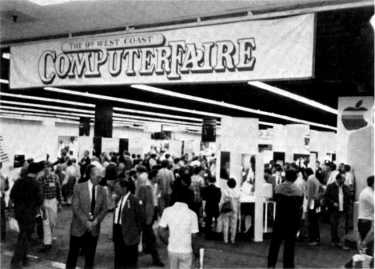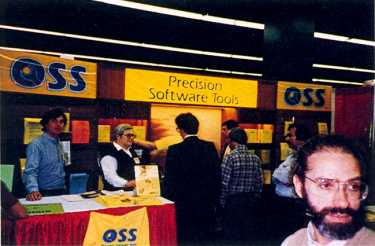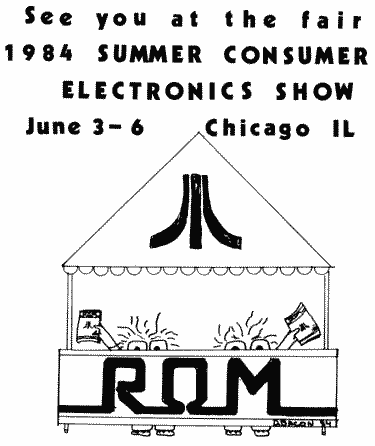ROM GOES TO
THE FAIRE
THE FAIRE
by Peter Ellison
ROM went to the 9th West Coast Computer Faire which was held on March 22-25 at San Francisco's Civic Auditorium and Brooks Hall. The show, one day longer then last years', featured more than 300 hardware and software exhibitors, including ATARI, IBM, TI, Apple, and Radio Shack.

The first day(Thursday), many of the exhibitors thought the show would be a flop, because not too many people attended. That was soon forgotten as during the next three days (Friday, Saturday, and Sunday), people were lined up outside Brooks Hall, long before it even started. I'm glad that we were exhibitors or we may not have gotten in. Admission was quite reasonable at $12 a person. There was so much to see that many people bought the four day pass for $20. Over sixty thousand enthusiastic potential buyers passed through the show.
Atari had a large exhibit with over fifteen television sets displaying either game, business, or educational program on the screen. This was very popular with the kids, because no where else can you pay $12 and play new games all day. One new Atari game that really impressed me was 'Equestrian', a game that was submitted to APX to compete for the Olympic award. This game featured diagonal scrolling of an equestrian course filled with jumps, waterholes, and barrels. I can say that the graphics and play were very good as I, myself, had to play a few games. Another interesting program called `SYNFILE+' caught my eye. Developed by Synapse Software for ATARI, this home and business management program allows one to create files and records. It also has business applications since it can be used for reports such as expenses, invoices, addresses, and customer lists. This program is a much improved version of the popular Filemanager 800+ from Synapse.
Besides games and business programs, ATARI had some very excellent educational software & hardware to show off. A new line called `AtariLab Science Series' was one that aroused the interests of many educators. The starter kit contains the AtariLab Interface-a panel that all AtariLab modules plug into-along with everything one would need to set up his own temperature and heat-energy experiments. This package comes with a temperature sensor, an electronic thermometer that sends temperature readings to the computer; plus a standard bulb thermometer for field checks and calibration. This new educational line, developed by a team of science professors at Dickinson College, has created a whole new approach to learning.
Besides being able to use the AtariLab interface with the cartridge supplied, students can write programs in Basic or whatever, to access the AtariLab interface and make up their own experiments. A second module is available at this time called AtariLab Light Module. Modules being developed for Atarilab that will be out in the near future include: Biofeedback, Timekeeper, Lie Detector, and different Mechanic modules. Why didn't they have this when I went to school?
Also at Atari's booth were some learning programs to help preschoolers. They were: "Juggles' House for Ages 3-6", and "My first Alphabet for Ages 3-5"(an oldy but goody from Fernando Herrera). Another interesting program was `TIMEWISE', a program to help a person keep track of his own time. This can be used to track one or several people's calenders or even a small business. That's all at this time for ATARI but we'll probably see them again this summer at the Consumer Electronics Show in Chicago.

Also at the show was Bill Wilkinson and the staff from OSS demonstrating ACTION! (reviewed in this issue), BASIC XL, and MAC-65. Other new products included a word processor called, `The Write Tool', a mailing list program called,`The Postal Tool' and `Sort Tool', and a special program for printing text called,-what else, -`The Print Tool'. Their booth, being right across from ATARI, put them in a very busy intersection. ROMOX was also at the show with an innovative way of selling software. They have a new machine that allows one to bring back his cartridge when he or she is bored with it, and have it reprogrammed. The cost of this is a fraction of that of a new cartridge. They offer a wide range of games from different companies to chose from. This type of thing is something for the future.
Amdek had their 3" Micro-Floppy Disk Drive for the Atari showing the vast amount of information that can be stored on one disk. One double-sided cartridge can store 720K bytes, 8 times the storage available on single-density 5¼" diskettes. Although not much software is available on these cartridges right now, plans are being made with major manufacturers to satisfy this requirement. Strategic Simulations was also there in full force, showing off a new fantasy adventure game, `Questron'. Although they didn't have the Atari version ready when we were there, it should be out by the time you read this article. Another program, just released, that is sure to be a classic is 'Broadsides'. In it you are the captain of an 18th century warship having to fight other ships in an arcade of strategic situation. `Rails West', a simulation of buying and selling railways back in the 1870's, was also just released (reviewed in this issue), adding another excellent addition to SSI's product line.
The Jay Gee Programming Company were showing their latest learning tool, `Attack of the Spelling Bees'. This game, which is 100% machine language, is an educational arcade-action spelling game for the ATARI. The game makes use of the joysticks, having the player move his bumblebee near the letters. The game disk contains 250 common words. Additional lists are available from Jay Gee. That's about all I saw at this fair, but will have more for you in the next issue after we have been to the Consumer Electronics Fair in Chicago.
